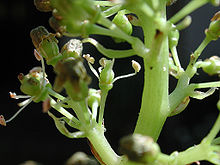BBCH scale for grapevines
The BBCH scale for grapevines describes the phenological development of the grapevine according to the scheme of the BBCH scale .
The BBCH code provides information about the morphological development stage of a plant . The acronym officially stands for Biological B undesanstalt, B undessortenamt and CH emic industry. The scale was developed in 1994 by Lorenz et al. presented.
Plant protection recommendations are given today in relation to the development stage according to BBCH.
| Stage of development | code | description |
|---|---|---|
| 0: bud development / germination | ||
| 00 | Hibernation | |
| 01 | The buds begin to swell | |
| 03 | End of bud swelling | |
| 05 | “Wool stage”: brown hair on the bud becomes visible | |
| 07 | Beginning of the bud break | |
| 09 | Bud burst: the green shoot tip that develops from the bud is clearly visible | |
| 1: leaf development | 11 | The first leaf has unfolded and is spread apart from the shoot |
| 12 | 2 leaves unfolded | |
| 13 | 3 leaves unfolded | |
| 1x. | x leaves unfolded | |
| 19th | 9 leaves or more unfolded | |
| 5: Evidence / inflorescences | 53 | Evidence clearly visible |
| 55 | The boulders are getting bigger but the single flowers are still densely packed | |
| 57 | The bills are fully developed and the individual flowers spread apart. | |
| 6: flower | 60 | Beginning of flowering. The first flower caps separate from the flower base |
| 61 | Beginning of flowering. 10 percent of the flower caps have detached from the flower base | |
| 62 | 20% of the flower caps are thrown off | |
| 63 | Pre-flowering: 30% of the flower caps are shed | |
| 64 | 40% of the flower caps are thrown off | |
| 65 | Full flower: 50% of the flower caps are thrown off | |
| 66 | 60% of the flower caps are thrown off | |
| 67 | 70% of the flower caps are thrown off | |
| 68 | Outgoing flower: 80% of the flower caps are thrown off | |
| 69 | End of flowering | |
| 7: fruit development | 71 | Fruit set: ovaries enlarge, last flower caps are thrown off. |
| 73 | Berries the size of a meal; the grapes sink. | |
| 75 | Berries the size of a pea with hanging grapes | |
| 77 | The first berries touch each other = start of the grape closure | |
| 79 | End of the grape closure = the stalk structure is covered by the berries. | |
| 8: Seed ripeness / ripening of berries | 81 | Beginning of ripening: the first berries change color |
| 83 | 50% of the berries have changed color (in French Véraison ) | |
| 85 | The berries soften | |
| 89 | Fully ripe berries (readiness for harvest) | |
| 9: withering away | 91 | After the berry harvest; Wood ripening is completed. |
| 92 | Beginning of foliage coloring | |
| 93 | Beginning of leaf fall | |
| 95 | 50% of the leaves have fallen | |
| 97 | End of leaf fall |
literature
- Horst Diedrich Mohr (Hrsg.): Color atlas diseases, pests and beneficial insects on the grapevine . Eugen Ulmer, Stuttgart 2005, ISBN 3-8001-4148-5 .
- Karl Bauer, Ferdinand Regner , Barbara Schildberger: Viticulture . 9th edition. avBook published by Cadmos Verlag, Vienna 2013, ISBN 978-3-7040-2284-4
Web links
- BBCH monograph (PDF; 2.37 MB; German)
Individual evidence
- ↑ DH Lorenz, KW Eichhorn, H. Bleiholder, R. Klose, U. Meier, E. Weber: Phenological stages of development of the grapevine (Vitis vinifera L. ssp. Vinifera) . In: Vitic. Enol. Sci. , Vol. 49, pp. 66-70, 1994 publication
- ↑ Approved plant protection products
